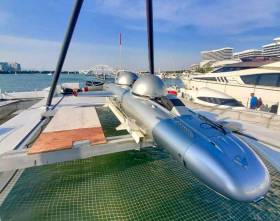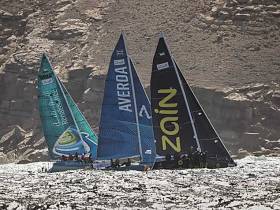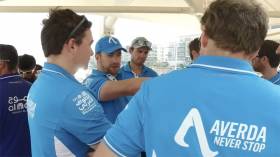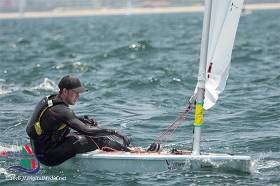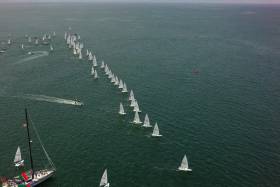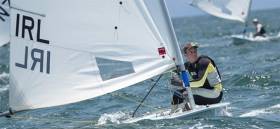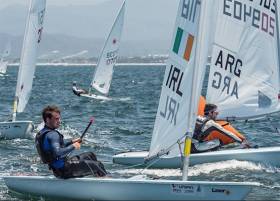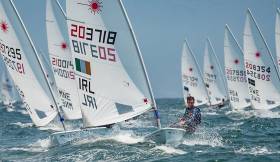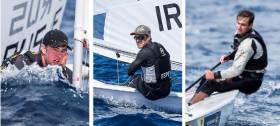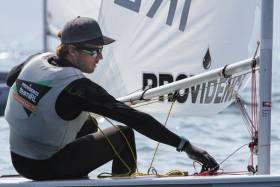Displaying items by tag: James Espey
Bangor Olympian James Espey Making Most of San Francisco Move to Explore Five Oceans
It’s a long way from Ballyholme near Bangor to Sugardock in Point Richmond on San Francisco Bay writes Betty Armstrong. But James Espey has made the leap and works as boat captain for Chris Welsh, among whose job titles are Strategic Consultant and Owner and Chief Sub Pilot for the Pentarius Project – (Its mission is to explore the depths of the five oceans).
James started sailing at Ballyholme Yacht Club age 10 and is an outport member of BYC and Royal Ulster. The 35-year-old sailor is known to his friends as Bapsy. (He got that nickname when he sailed in the Cork 1720 with Gareth Flannigan who had to ask him continually to ‘move your Bap’ out of the way of the instruments). James counts the first event he won as the 1720 Nationals in Cork in 1998. Principally a Laser Standard helm, his standout results are probably 1st in the Silver Fleet of Sail for Gold in 2009 and 4th in the same fleet in the 2012 Sail for Gold regatta. Another top-scoring result was a 4th in the Silver fleet in the Sydney International Regatta. In 2012 he secured a place in the London Olympics in the Laser Standard and in 2017 he raced across the Atlantic on CQS.
James looks after Welsh’s investments in sailing. He is based in Sugardock in San Francisco and involved in a lot of interesting boats and projects. Sugardock is a uniquely configured full-service deep-water dock on San Francisco Bay, about 7 miles by water to downtown San Francisco.
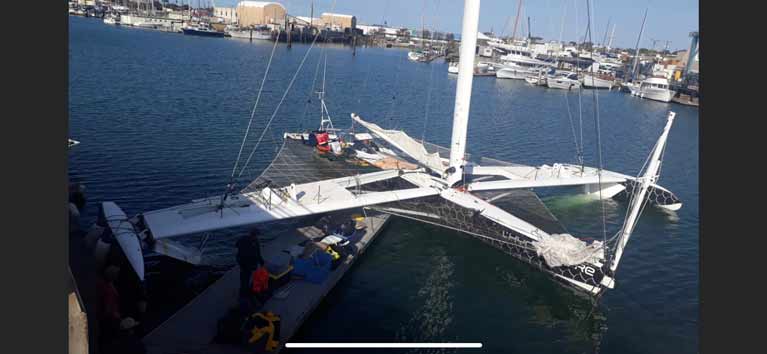 L'hydroptere
L'hydroptere
One of the projects is L'hydroptere, owned jointly by Chris Welsh and Gabriel Terrasse. She is a French experimental sailing hydrofoil trimaran imagined by the yachtsman Éric Tabarly. The project was managed by Alain Thébault, the design done by naval architects VPLP design and the manufacturing by a group of French high-tech companies. She was abandoned in Hawaii for 5 years. After being bought in an auction she was rebuilt and brought back to San Francisco, the plan being, as James says, to “make her fly again in San Francisco”.
Now not content with one big project James is also involved in the complete rebuild of Ragtime which was one of the world's fastest yachts in the 1970s. In 1973 she became famous for beating the favourite, Windward Passage by 4 minutes, 31 seconds, in the Transpacific Yacht Race from Los Angeles to Honolulu. With new sails, mast, winches, engine and repainted interior she will eventually James hopes, make the passage to Europe and he then wants to bring her to his home town of Bangor.
Another interesting project based in Sugardock is the Pentarius Deep Sub.
The pressure hull is built of carbon fibre with an aluminium dome at the back end and a fused quartz dome at the front. Chris Welsh bought the Submarine company and travels all over China and Japan in the vessel carrying the submersibles, the 38 m Cheyenne, the old PlayStation. The plan is to build the subs in the Sugardock yard.
At present James splits his time between London and California, and he and his wife, Genny Tulloch, an accomplished yachtswoman and social media producer, reporter and presenter, plan to live in San Francisco and spend time also in London.
Baker & Espey Battling Hard in Sailing Tour of Arabia
Northern Ireland sailors Andrew Baker and James Espey are fighting hard in the Sailing Arabia Tour onboard Team Averda but it is a veteran crew that saw off spirited attacks from rivals Team Al Mouj Muscat (OMA) and Team Zain (KUW) to seal the top spot in the 153-nautical mile sprint from Khasab on Oman's Musandam Peninsula to Abu Dhabi.
The triumph, their second in three legs, is all the more impressive given the hurdles EFG Bank Monaco faced on the leg – at one point their Farr 30 racing yacht became entangled in a fishing net, causing them to lose the lead to Team Al Mouj Muscat, but they were able to recover and overhaul their rivals in the early hours of this morning.
It puts the three-time winners of EFG Sailing Arabia – The Tour, led by Frenchman Thierry Douillard and including former match racing world champion Mathieu Richard, 4 points clear at the top of the overall standings with two offshore legs and two in-port race series remaining.
“It was a great leg – we had a good start sailing around the beautiful Musandam coastline and we were fast,” Douillard said.
“We sailed solidly and were leading at the first gate just as night came. We then had some issues with fishing nets... we were caught for quite a while by a big one and slipped back to fourth. We fought back very hard because we knew we would be reaching at the end of the leg with little opportunity to overtake. I'm very happy with the job the boys did.”
Team Al Mouj Muscat notched up another second-place finish, coming in just eight minutes adrift of EFG Bank Monaco's winning time of one day, two hours and 55 minutes.
But the biggest celebrations came from Team Zain, who scored their first podium result after having to settle for fourth in the two opening legs.
“We're absolutely delighted with the result,” said Team Zain crew manager Mike Miller.
“At one point we were actually leading but as we came into the home strait the professional crews took us to the cleaners. Thankfully we were able to hang on this morning and score our first podium of this year's race. It was hard work but we really deserve this result.”
Behind the top three an intense battle raged for fourth place between Leg 1 winners Team Renaissance (OMA), race newcomers Adelasia di Torres (ITA) and Bienne Voile (SUI).
After more than 26 hours at sea the three crews finished within 90 seconds of one another, Team Renaissance coming home just ahead of Bienne Voile and Adelasia di Torres.
Team Averda (GBR) took seventh place ahead of all-female crew DB Schenker (GER) in eighth.
The teams now have a day in the UAE capital city to recover before racing resumes on Wednesday morning with Leg 4, the penultimate stage of the 763nm Arabian classic that will see the fleet race to Doha, Qatar, a 160nm stage with another night – if not two – at sea.
Once in Doha the teams will contest the second in-port race series of EFG Sailing Arabia – The Tour, a vital opportunity to score points before the final offshore leg to Dubai which begins on February 26 and a last in port race.
Results of Leg 3:
EFG Bank Monaco (MON/Thierry Douillard) – 1.5 points
Team Al Mouj Muscat (OMA/Christian Ponthieu) – 3 points
Team Zain (KUW/Cedric Pouligny) – 4.5 points
Team Renaissance (OMA/Fahad Al Hasni) – 6 points
Bienne Voile (SUI/Lorenz Mueller) – 7.5 points
Adelasia di Torres (ITA/Renato Azara) – 9 points
Team Averda (GBR/Andrew Baker) – 10.5 points
DB Schenker (GER/Annemeike Bes) – 12 points
Overall results:
EFG Bank Monaco (MON/Thierry Douillard) – 5 points
Team Al Mouj Muscat (OMA/Christian Ponthieu) – 9 points
Team Renaissance (OMA/Fahad Al Hasni) – 11.5 points
Team Zain (KUW/Cedric Pouligny) – 14.5 points
Adelasia di Torres (ITA/Renato Azara) – 23 points
Bienne Voile (SUI/Lorenz Mueller) – 26.5 points
Team Averda (GBR/Andrew Baker) – 27 points
DB Schenker (GER/Annemeike Bes) – 27.5 points
Andrew Baker & James Espey Race In Sailing Arabia – The Tour
#SailingArabia - Strangford Lough solo sailor Andrew Baker is following his role in Enda O’Coineen’s Vendée Globe campaign with a new job as skipper of the Averda Sailing Team in the EFG Sailing Arabia – The Tour 2017.
‘Hammy’ replaces the injured Marcel Herrera as skipper of the team, and he’s joined by fellow Irish sailor and London 2012 Olympian, James Espey of Ballyholme YC, in the youngest squad to take part in the Gulf region’s only long-distance sailing event — which kicked off yesterday (Wednesday 15 February) and continues for the next two weeks.
The young upstarts will have their work cut out for them in an eight-boat fleet that set sail from Muscat yesterday and boasts top-ranking team sailing talent, from Volvo Ocean Race crew Dee Caffari to Dutch Olympic sailor Annemieke Bes, who skippers her own all-female German team DB Schenker.
The Averda Sailing Team Facebook page has video of action from the Tour’s first leg:
Finn Lynch Closes In On Olympic Laser Nomination As World Championships Conclude Today
A globe trotting Irish Olympic mens Laser trial comes to a conclusion in Mexico today with Finn Lynch leading the three boat contest for the single Rio berth. Lynch is 50 out of 56 in the gold fleet of the Laser World Championships that form the third Irish trial. Both the other trialists, Fionn Lyden and James Espey, are racing in silver fleet. All eyes are on Lynch for the Olympic nod later today after the last two races of the 112-boat championships are sailed.
Lynch Takes 45–Point Lead Over Espey At Laser Worlds Olympic Trial, Four Races Left to Sail
After five days of competition at the 112-boat Laser World Championships in Mexico, the National Yacht Club's Finn Lynch has built a lead of 45–points over James Espey in the race for the final Irish Olympic sailing berth in Rio. The big points cushion of Lynch's 187 versus Espey's 232 is important because this week's championships – that concludes tomorrow – is the final selection trial for the Irish Olympic mens Laser berth in Rio.
Going into the event last Thursday, (the last of three Irish trials since December), Belfast's Espey had earned a slender six point lead over the Carlow debutante but after ten races at Riviera Nayarit, the regatta has tipped in Lynch's favour. On Monday, Lynch was the only one of three Irish competing (Fionn Lyden of Baltimore is the third) to make the gold fleet cut. Yesterday, a black flag disqualification for Espey in the silver fleet has made things more difficult for the Ulster sailor to regain lost ground. Still, while the gap has widened, Lynch, currently lying 48th from 56 in gold, will be well aware four races remain to be sailed, making it arguably possible for Espey, (Ireland's London 2012 rep) to make a come back at the notoriously fickle venue.
Results are here
Finn Lynch Eyes Gold Fleet Place At Laser Worlds
In the Irish Olympic selection trial being sailed as part of the Laser World championships in Mexico, the rising star of Irish sailing Finn Lynch continues to build a points cushion over James Espey and Fionn Lyden for the single berth in Rio. The Irish Olympic spot will be decided when this championships concludes on Wednesday. A top class eighth placing in race five yesterday saw the National Yacht Club debutante move up to 58th overall. He is now 20–points clear of Lyden in 63rd and 46 points clear of Espey who is 78th in the 112–boat fleet.
Lynch has a final race of qualifying today and, significantly, stands on the cusp of a gold fleet place for the top 56–sailors in the fleet. Defending champion, Nick Thompson of Britain, regained his lead on Day 3. Full results here
The 2016 Laser Standard Championship at Nuevo Vallarta, Nayarit was always expected to be one of the highlights of the sailing year as the world’s top Laser sailors make their final preparations for the Olympic Games in Rio de Janeiro.
Winning a stand-alone world championship in an Olympic class is the ultimate goal for every sailor, apart from a coveted Olympic medal, and is certainly contributing to the pressure before the Games. A good result is not only a morale boosting personal achievement but also a message to your opposition in Rio to beware!
Defending a world championship title is a challenge only a few top sailors ever face, so for Great Britain’s Nick Thompson, returning to the top of the leader board after 6 races and a difficult day on the water is surely extra satisfying. Thompson finished first in today’s first race in the Blue Fleet to draw level on points with the overnight leader, Tonci Stipanovic of Croatia sailing in the Yellow Fleet. At the first mark the Croatian looked as if he would match Thompson race-for-race as he led New Zealand’s Sam Meech until the beginning of the second downwind leg when they split tacks. When they next met Meech had the advantage, which he held to the finish.
The second race for both fleets saw the usual southwesterly wind catch out a number of sailors as they expected the right side of the first windward leg to pay as it had in the previous race. The 11 knot wind increased to 13 knots and swung 10 degrees to the left soon after the start. Unfortunately for some the wind stayed left, stranding those who placed their faith in finding a right shift. Amongst these was Stipanovic, who suffered most in the Yellow Fleet rounding the first mark in 21st position, five places behind overnight 5thoverall Robert Scheidt. By the finish, Scheidt had made a good recovery to 8thand Stipanovic mirrored his gain to 14th, which became his discard. Slowly the first leg mix sorted itself out with Kristian Ruth from Norway improving his fourth place rounding at the top mark to take the winning gun ahead of his fellow countryman Hermann Tomasgaard and Philipp Buhl of Germany.
In the Blue Fleet it took three recalls to get the fleet away in a building breeze. The course was more balanced although the fleet still favored the right. Belgium’s Wannes van Laer did the best job of picking his way through the shifts in the center right to lead at the first mark ahead of Julio Alsogaray from Argentina and Australia’s Tom Burton. Meanwhile, Thompson protected the right to round in 7th. Van Laer swapped places with Alsogary on the first downwind as Thompson gained three places. By the end of the race Burton had taken first place, which with a 4th in the previous race made him the second most improved sailor of the day jumping 11 places up the leaderboard to 8th compared to best of the day, New Zealand’s Sam Meech, who climbed 13 places to 11thoverall.
Thompson now has a three-point cushion over new number two, Jean-Baptiste Bernaz of France, going into the final day of qualifiers before the real excitement begins in the finals series when the world’s top 56 Laser sailors race head-to-head.
Overall Results after 6 races with 1 discard
Nick Thompson GBR 10pts
Jean-Baptiste Bernaz FRA 13pts
Tonci Stipanovic CRO 15pts
Matthew Wearn AUS 18pts
Robert Scheidt BRA 21pts
Philipp Buhl GER 25pts
KacperZieminski POL 29pts
Tom Burton 32pts
Marco Gallo ITA 33pts
Wannes van Laer BEL 35pts
Finn Lynch Extends Trials Lead at Laser Worlds, 19 Points Separate Three Irish Sailors
In the Irish selection trial being sailed as part of the Laser World championships in Mexico, Finn Lynch has extended his lead over James Espey and Fionn Lyden for the single berth in Rio. While there is only one point between the leaders at the top of the fleet only 19 points separate the Irish trio. Lynch is 64th, Lyden 71st and Espey 83rd in the 112–boat fleet.
The Dun Laoghaire sailing star, who is a Youth World Championship silver medallist and U–19 Laser World champion, trailed Espey by six points going into this week's Laser Worlds so must maintain his current advantage to be sure of his Rio berth. Read more about the Irish trialists final battle here.
Tonci Stipanovic from Croatia heads the leader board with a well deserved win in the first race of Day 2. In a 10–knot south westerly breeze Matthew Wearn from Australia led the blue fleet round the first mark ahead of Wannes van Laer BEL and Julio Alsogaray ARG. Stipanovic took the lead ahead of Wearn after a good second windward leg when both pulled clear of Alsogaray and the chasing pack to then lead the fleet home. Germany’s Olympic representative, Philipp Buhl, was a major casualty at the start of the blue fleet race when he had to retire after being given a second yellow flag penalty on the start line.
In the yellow fleet, sailing on the outer loop, overnight leader Nick Thompson GBR, could only manage a 5th behind Jean-Bapiste Bernaz and the first three Marco Gallo ITA, Kacper Zieminski POL and Franccesco Marrai ITA who traded places in front of him.
The wind increased for the second races of the day bringing larger waves enabling sailors to catch some good downwind rides and, for a few, also the attention of the on-water jury.
The previously favoured right right-hand of the course was not so dominant although most of the favourites scored well. In the yellow fleet, Olympic silver medalist, Pavlos Kontides CYP won the port end pin position at the start and tacked to cross the fleet early to lead all the way home ahead of Bernaz. 5 places back from the pin Thompson got trapped at the port end and had to take a two turn penalty after he inadvertently impeded another boat whilst trying to clear his wind. Thompson did well to round the first mark in 20th and then recover to 13th which is currently his discard race.
Luke Elliot AUS also led from start to finish in the blue fleet with Alsogaray and Scheidt again in single figures after both climbing through the fleet.
5 points separate the first 7 places in the overall results after 2 more races at the Laser World Championships at Vallarta, Nayarit, Mexico.
Top Ten Overall Results after 4 races with 1 discard
Tonci Stipanovic CRO 6pts
Nick Thompson GBR 7 pts
Jean-Baptiste Bernaz FRA 8pts
Matthew Wearn AUS 9pts
Robert Scheidt BRA 10pts
Julio Alsogary ARG 10 pts
Francesco Marrai ITA 11pts
KacperZieminski POL 14pts
Philipp Buhl GER 18pts
Marco Gallo ITA 20pts
Just fifteen places in a fleet of 112 sailors from 44 countries separated the three Irish sailors competing at the 2016 Laser Standard Men’s World Championship in Mexico yesterday.
Britain's Nick Thompson has opened his Laser title defence with a perfect 1,1 score and in the final Irish selection trial being sailed as part of the championships, Finn Lynch leads James Espey and Fionn Lyden, although results in the 60s and 70s will not be the kind of performance Ireland is hoping for in Rio in August. Lynch is 62nd, Lyden 73rd and Espey 77th. Read more about the Irish trialists final battle here.

Competitors enjoyed sparkling conditions of 12 to 15 knots in the waters off Nayarit on the west coast of Mexico. The total fleet is sailing in two groups during the qualifying series to determine the gold and silver fleets.
The first fleet was a little jumpy in the lighter conditions at the beginning of the day and needed 3 attempts to start before getting away on fourth start. In the process, 7 boats were taken out by the black flag for breaking the start line, including 9 times world champion, Robert Scheidt from Brazil.
On the final start in a building breeze Croatia’s Tonci Stipanovic tacked quickly on to port off the start line and headed for the starboard side of the course on a two-tack first beat. His tactic helped him to round the first mark in the lead, a position he held to the finish ahead of Milivoj Dukic from Montenegro. Behind him Philipp Buhl from Germany pulled through from 9th to 4th and then to 3rd by the finish.
The blue fleet started on the first attempt with Mark Spearman (AUS) rounding the first mark in the lead but was soon overtaken by Nick Thompson (GBR). “I had a good start and protected the right-hand side and rounded in fifth behind the guys who went further right” said Thompson. “I managed to gain places on the downwind second leg to get the lead at the bottom of the run and then hold on to the finish”.
In spite of a large swarm of bees landing on the Race Committee signal boat and pin boat, both fleets got away first time with clean starts for the day’s second race. In the yellow fleet race Scheidt made up for his previous black flag start to lead the fleet to a comfortable win ahead of Jean-Baptiste Bernaz of France and Andy Maloney from New Zealand.
In the blue fleet, Thompson got another good start from a slightly favoured pin and was able to cross over to the right side of the course to round the first mark just behind Julio Alsogarey ARG and ahead of Matthew Wearn AUS. Thompson pulled through to first on the second windward leg to take the gun ahead of Alsogarey and Wearn.
Qualifying racing continues today with two more races scheduled in the 14 race series. Overall results after 2 races without discard.
Nick Thompson GBR 2 pts
Tonci Stipanovic CRO 5 pts
Matthew Wearn AUS 7 pts
Jean- BaptisteBernaz FRA 9 pts
Millivoj Dukic MNE 13 pts
Andy Maloney NZL 14 pts
Philipp Buhl GER 15 pts
Kacper ZieminskiPOL 16 pts
Jesper Stalheim SWE 17 pts
Lorenzo Brando Chiavarini GBR 17 pts
Three Irish Contenders For Olympic Laser Berth in Mexico
As Afloat.ie previously reported, the final selection event to decide the Irish laser sailor for the Rio 2016 Olympic Games begins in Puerto Vallarta, Mexico today, where three Irish contenders will be in action. RESULTS AFTER DAY ONE ARE HERE.
The Men’s single-handed event in the Laser Standard class is being closely contested with the outcome hanging by a thread as London 2012 veteran and Providence Team IRL member James Espey from Ballyholme comes under pressure from ISA Development sailor Finn Lynch of the National YC.
Baltimore’s Fionn Lyden has demonstrated future potential in the trials that started over five months ago at the Olympic venue in a test event but will need a significant jump in form to win the nomination.
Racing begins in the world championships today at 1pm (6pm Irish Time) and continues for the coming seven days concluding on Wednesday18th. The first four days of racing will be qualification rounds that decide the fleet splits into Gold and Silver groupings. Unlike the Olympic Regatta format, there is no medal race final for the top ten boats.
On the trials standings after two previous events, Espey holds a narrow six-point lead over Lynch. Lyden trails by 20 points. In the large fleets competing in the worlds, finishing places between the Irish boats are likely to be spread out so the overall lead for the trials could easily change in the course of one or two races.
Although Espey has the upper hand in terms of experience and the overall lead, Lynch is a rising star of Irish sailing. As a Youth World Championship silver medallist and U19 Laser World champion, he is a clear threat to the incumbent having recently beat Espey to win the Ulster Laser Championships.
“While all three boats will be aiming for a Gold fleet result in this event, they will inevitably be aware of one another’s placing as the trials standings are so close,” commented James O’Callaghan, ISA Performance Director. "It has been a nail biting trials so far and that trend is likely to continue in Mexico"
As Afloat.ie reported previously, Last month saw Annalise Murphy from the National YC win the trials for the sole Irish slot at Rio 2016 for the Women’s Laser Radial event. In the 49er skiff event, Ryan Seaton with Matt McGovern and 49erFX sailors Andrea Brewster with Saskia Tidey also await a decision by the board of the ISA to be nominated to the Olympic Council of Ireland for inclusion in the national team for Brazil.
Espey Backs 'Flow' Campaign For Watersports In Northern Ireland
#JamesEspey - Olympic Laser hopeful James Espey made time in his busy Rio 2016 training schedule for to help launch a new campaiign aimed at getting people involved in watersports, according to the News Letter.
As previously reported on Afloat.ie, the Flow campaign is a partnership between SportNI and various sporting bodies that's encouraging water-based activities in the run up to September's European Week of Sport.
Watersports clubs around Northern Ireland will be offering taster events on the weekend of 14-15 May to get things running, and Espey is fully behind the initiative.
"This new Flow campaign is absolutely ideal for those with no background in watersports whatsoever," said the Olympian who still trains where he first learned to sail at Ballyholme.
“It will be a fantastic introduction for anyone wanting to get into water based activities across Northern Ireland.”
The News Letter has more on the story HERE.


























